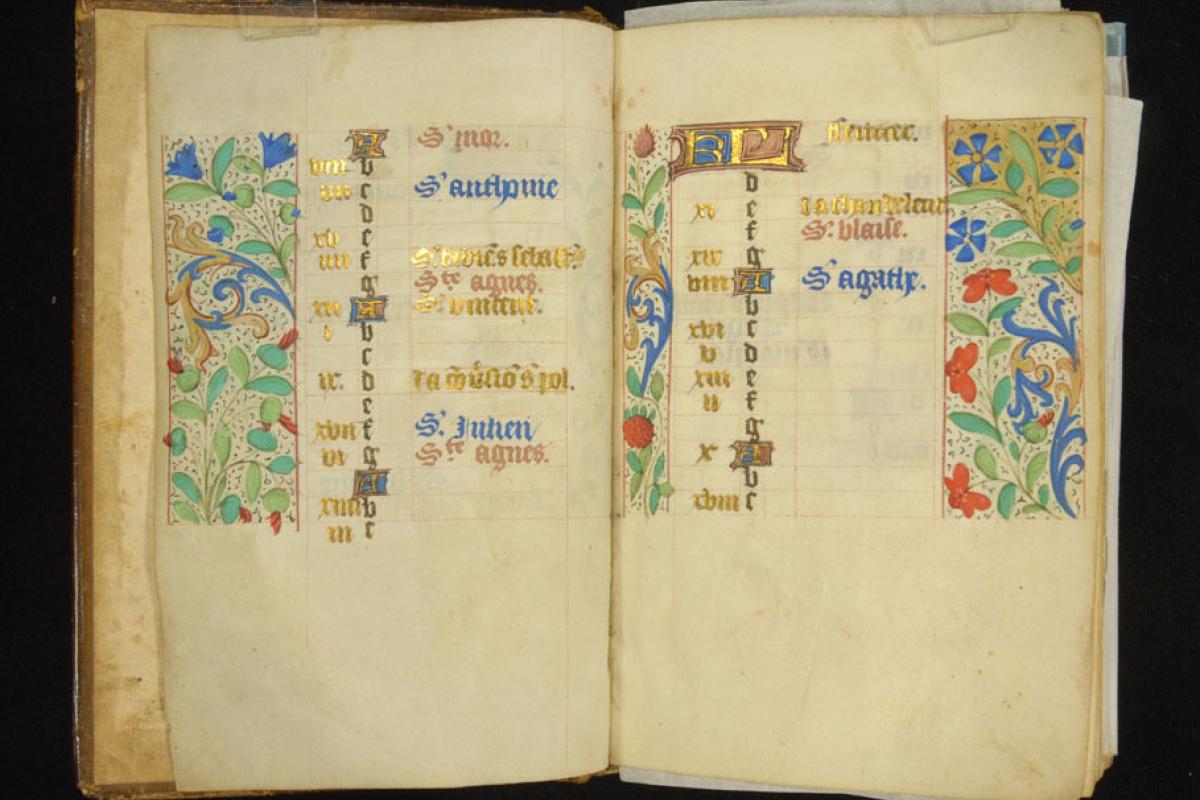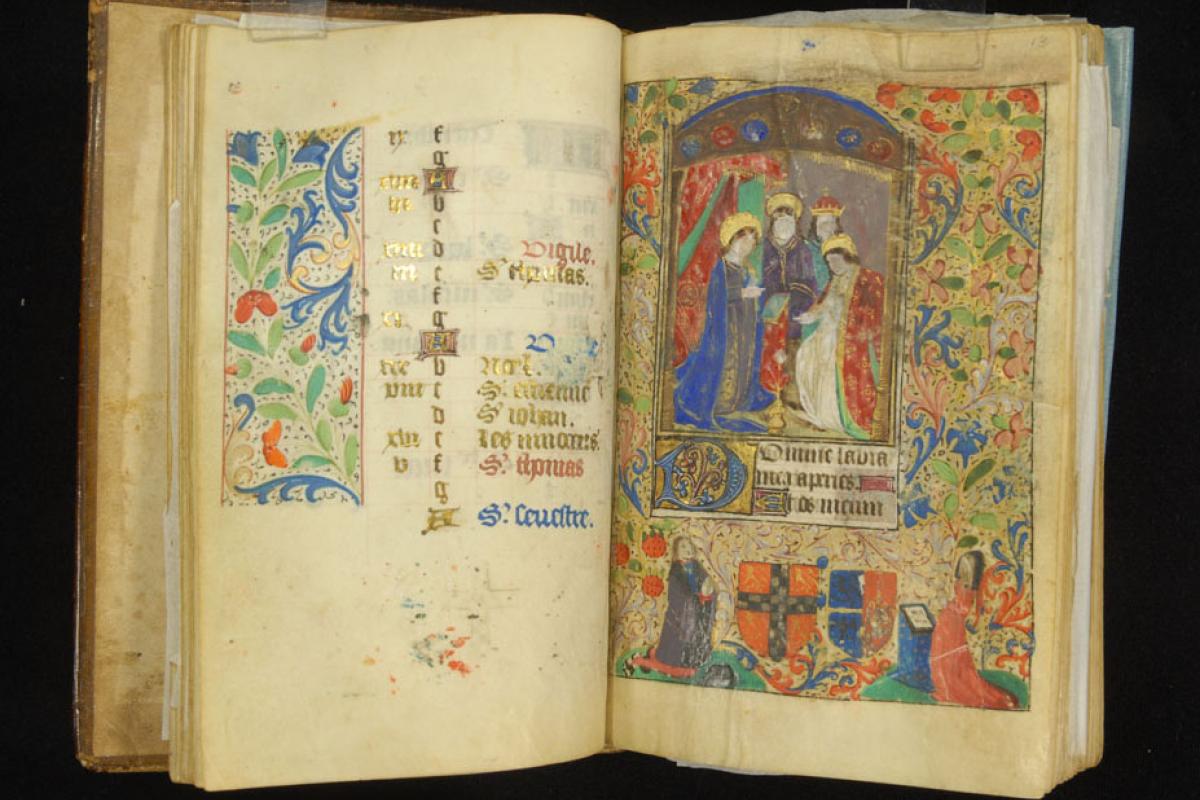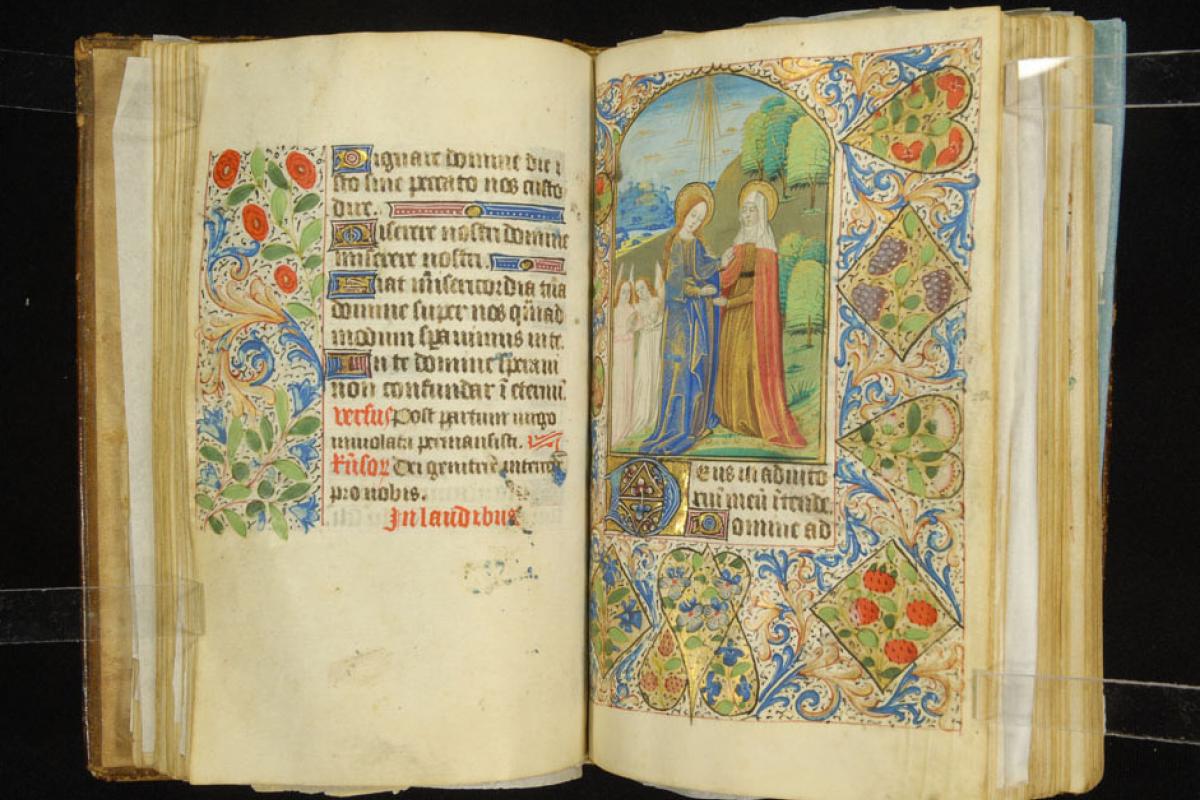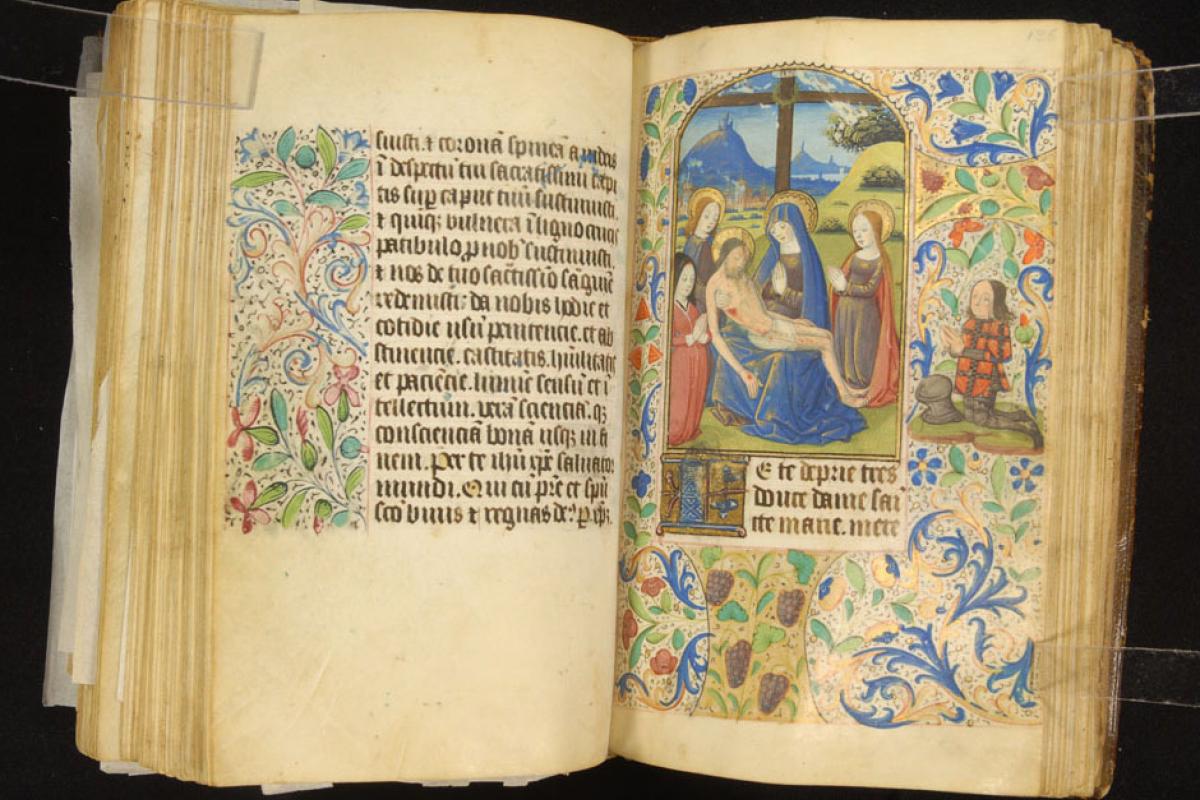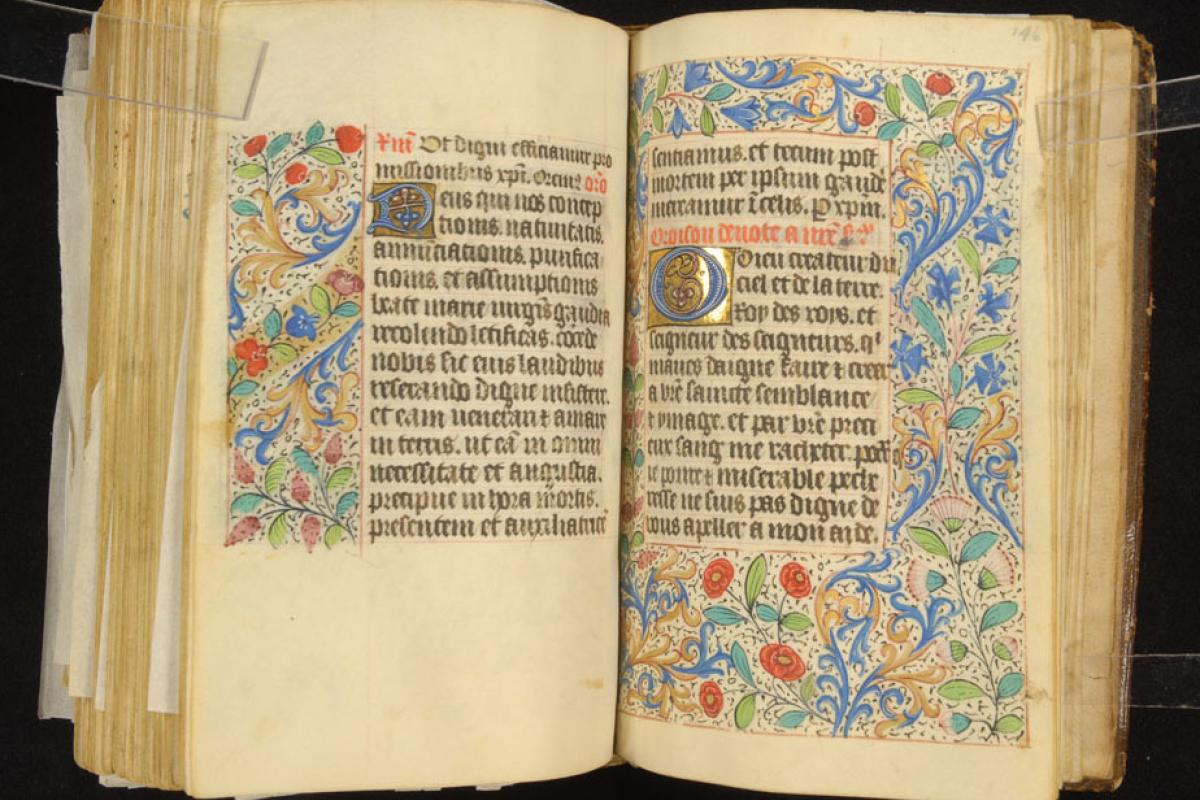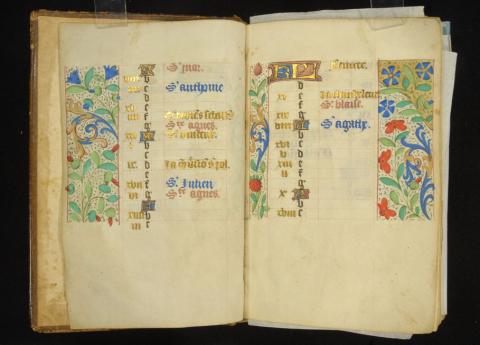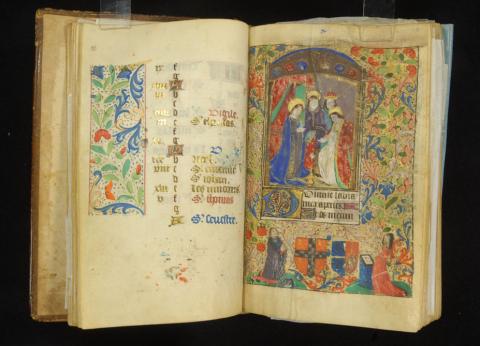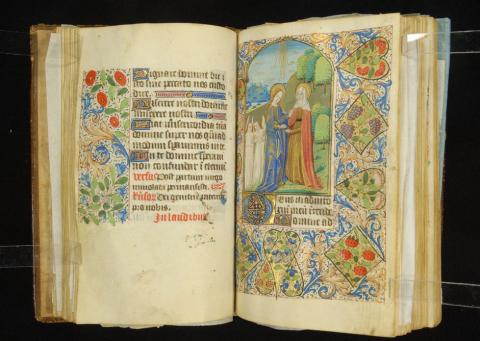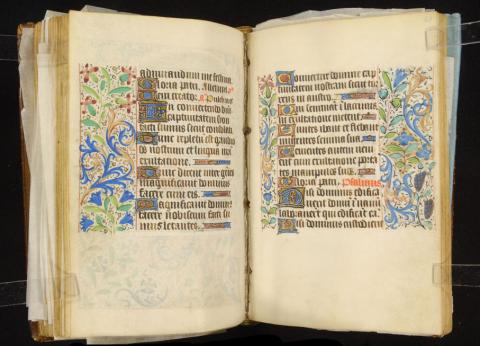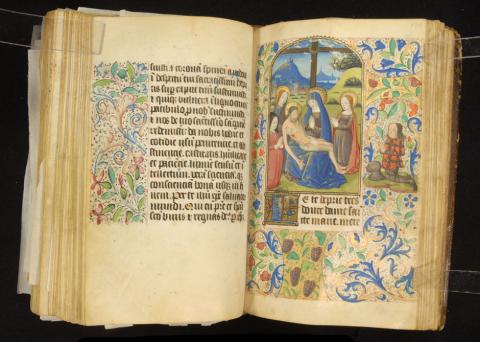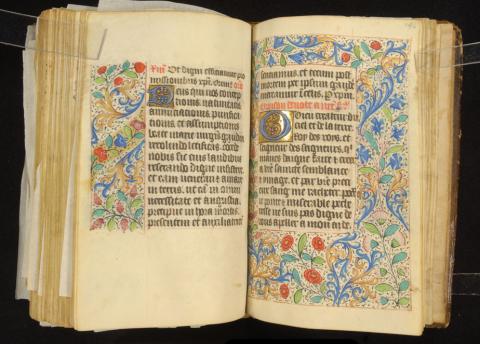Book of Hours, Use of Rouen
Book of Hours, Use of Rouen
French (Northern France), ca. 1475
Images:
fols. 2v-3r: Calendar pages
fols. 12v-13r: Annunciation (Hours of the Virgin, Matins) with donor portraits
fols. 24v-25r: Visitation (Hours of the Virgin, Lauds)
fols. 60v-61r: Text pages from Hours of the Virgin
fols. 134v-135r: Pieta (Prayers to the Virgin) with donor portrait
fols. 145v-146r: Text pages with floral border
height 18.5 cm
width 12 cm
162 leaves. Pointed Gothic script. 15 lines. Gatherings mostly of 8. Text in Latin and French: Calendar, Hours of the Virgin, Psalms, Litany, Prayers for Souls in Purgatory, Office of the Dead, Passion according to Matthew, Prayers, Gospel lessons, 15 Articles of Faith. 13 large miniatures with border decoration. Binding: brown calf with gold-tooled decoration, medallions with the Crucifixion (front) and Annunciation (back) and the name “Francoise Boucher,” 17th c.
Prior Publication: Lackaff, Dalene G., A descriptive catalogue of the manuscript books of hours in the collection of the Mount Angel Abbey Library, M.A. Thesis, University of Oregon, 1999, pp. 46-57
Provenance: The de Melleu family (inscription); Françoise Boucher.
Mount Angel Abbey Library, Ms 30
Jeff Brown, Medieval Portland Research Assistant
Like Mount Angel Mss. 29, this Book of Hours is a product of the high-yield, mass-production workshops of late fifteenth century Rouen. Using stock imagery, several artists, at least three, figured in the creation of this book. Saints included in the calendar were not limited to Rouen, but show a predominant interest in northern France. A donor portrait identifies the manuscript’s two patrons as members of the upper class of Rouen: a coat of arms is included.
The scene of the Annunciation has been heavily overpainted, but not so much as to overshadow its resemblance to the Annunciation scene of the Playfair Hours, a contemporary production from a similar Rouen workshop. However, the addition of a haloed saint and a crowned king to the scene, likely executed by the behest of a later owner, are of significant interest, as no precedents or comparanda for these figures are known.
Parshall, Peter. Illuminated Manuscripts from Portland Area Collections. Portland, OR: Portland Art Museum, 1978, p. 28 - Quoted with permission
Of the various centers of illumination in northern France during the late fifteenth century, Rouen was undoubtedly the most productive source for lavishly decorated Books of Hours. Large numbers of these manuscripts betray a homogeneous but elegant standard of production less inclined to originality than conspicuous display. The unrestrained use of mat gold paint, the introduction of stock donor portraits, and a rather precious figure style are typical features of the Rouen school. We can infer that division of labor within workshops was especially common by this time as a means of meeting the inflated demand for prayerbooks. Two sets of donor portraits appear in this manuscript, one included in the original stages of production—a young woman in prayer in the Pieta with a knight kneeling in the border (135r). Such figures are of a general, anonymous type and indicate a book offered for sale on the open market. The knight's armor was modified to bear the insignia of the arms accompanying the second set of donors added shortly after. The second pair is located beneath the Annunciation (13r). Curiously, the Annunciation itself contains two additional figures (one crowned with a coronet) behind the Virgin and Gabriel. The implications of this odd variation in a standard subject are unclear.
Wilma Fitzgerald, PhD, SP - Quoted with permission from an unpublished study
Liber horarum Beatae Mariae Virginis. Rouen Use. Saec. XV ex. N. France. FF 162 vellum + ii paper (Note watermark in paper). 185 x 120 (90 x 64) mm., one column, 15 lines. With borders (90 x 110-115). Rubrics in French and Latin. Donor portraits on ff. 135 and 13. Arms: Male shield: Gules, a cross chequey argent and sable, four lions rampant sable. Female shield: Azuure per fess: first a lion rampant sable, third and eagle displayed sable, impaling gules, a fleur-de-lis. Latter shield overpainted, both unidentified. The de Melleu family (inscription); Francoise Boucher.
Miniatures include: Annunciation. Praying male and female donors in border,Visitation, Crucifixion, Pentecost, Nativity, Annunciation of the Shepherds, Adoration of the Magi, Presentation in the temple, Flight into Egypt, Coronation of the Virgin, David Penitent, Mass of the Dead, Pieta with Female donor, male donor in border. Borders with vegetable ornament are included on every page; some panels in gold. Full borders on all four sides of pages with miniatures, on all other pages borders are in outer margin, equal in height to text block. Three-line initials in red, blue, and gold beneath miniatures. Many 1- and 2-line initials in red, blue, and gold; decorated line endings. Binding is 17th century of brown calf with gold tooled decoration on spine. Front has central oval medallion of Crucifixion, winged angel head with foliage in each corner. Upper corner stamped Francoise. Back has same pattern with Annunciation in medallion and Boucher stamped above. See Parshall, Illuminated Manuscripts # 11, pp. 28-29.
Calendar (in French); Hours of the Virgin, Use of Rouen; Prayers to Holy Spirit, Trinity, Dionysius, Nicholas, Maurus, Mary Magdalen and Margaret; Excerpts from gospel of John; Short Hours of the Cross and Holy Spirit; Seven Penitential Psalms; Litany, and prayers; Prayer for the sinful, Ave te omnes animae fideles; Office of the Dead; Passion excerpt secundum Mattheum (actually excerpts of John 19, 1-35; Obsecro te (in French); Prayers (in French and Latin) Mere dieu qui fustes mise (Leroquais 11325), Ave cuius conceptio (Chevalier 1744), Deus qui nos conceptionis (Walters 91), O dieu createur, Mon benoist dieu, (Leroquais ll330), Sire dieu tout puissant (Leroquais 11389); 12 articles of faith: Excerpts from Luke, Matthew and Mark evangelists;Prayers to Sebastian, Lawrence, Claudius, Mary Magdalene, Margaret, and Catherine, Prayer of Solomon.

